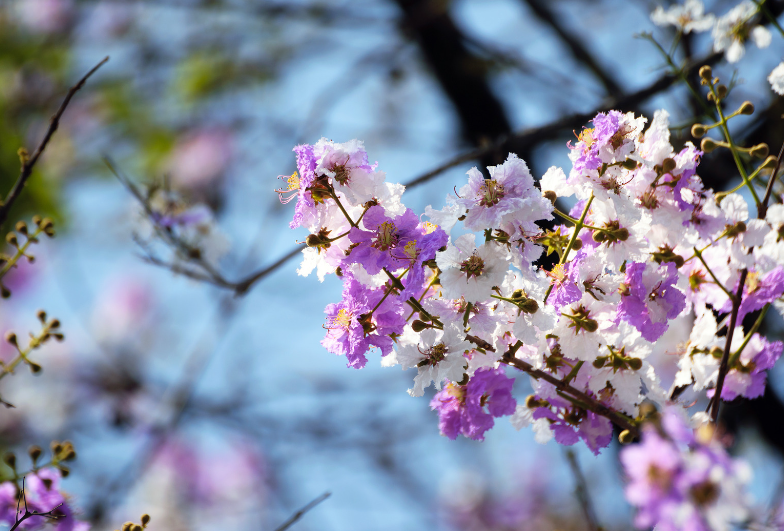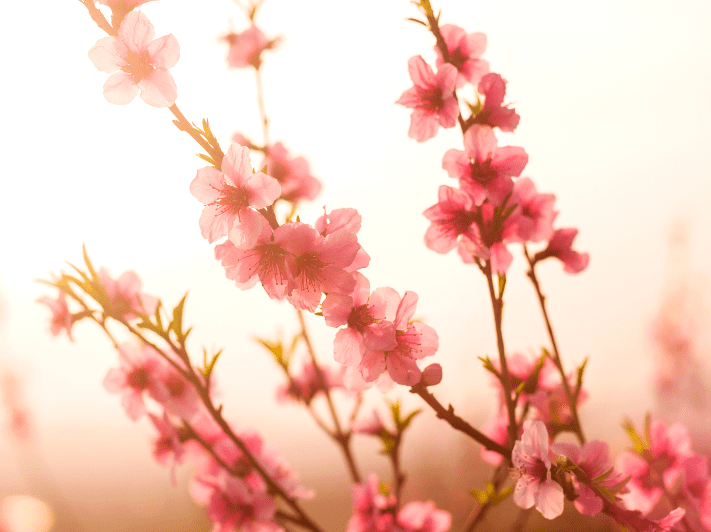
Regarding ornamental peach trees, the “Tequila Sunrise” variety stands out for its stunning appearance and manageable size. If you’re looking to add some vibrant colors and eye-catching blooms to your garden, this might just be the tree for you. Not only does it offer beauty, but it’s also relatively easy to care for, making it a favorite among gardening enthusiasts.
But what exactly makes the “Tequila Sunrise” flowering peach tree so unique? Let’s dive into everything you need to know about this fantastic ornamental tree.
Do Ornamental Peach Trees Bear Fruit?
You might wonder whether an ornamental peach tree like the “Tequila Sunrise” can bear fruit. The answer is yes, but the fruit is not typically the star of the show. While these trees may produce small peaches, they are often not as flavorful or juicy as those grown on standard peach trees. They can still be eaten, but they tend to be on the smaller side and are mainly grown for their visual appeal.
The primary focus of ornamental peach trees is their vibrant flowers, not their fruit. Gardeners typically plant these trees to enhance the beauty of their landscape rather than for fruit production. So if you’re looking for a tree that produces peaches for eating, you might want to consider a different variety.
Characteristics of Ornamental Peach Trees
What sets ornamental peach trees apart from other fruit trees? It’s all about the aesthetics.
Flowers: The “Tequila Sunrise” peach tree boasts large, showy flowers in shades of pink and red, creating a striking contrast against its dark green leaves. These blooms appear in early spring, making them one of the first trees to brighten your garden after winter.
Foliage: In addition to the blossoms, ornamental peach trees offer attractive foliage. After the flowers fade, the tree is adorned with glossy, green leaves that turn golden yellow in the fall, adding another layer of seasonal beauty.
Comparison to Other Ornamental Trees: When compared to other ornamental trees like crabapples or purple-leaved plums, the peach tree offers more diversity in both its flowers and foliage. While crabapples also have beautiful blooms, they don’t quite match the bold, tropical-like colors of the “Tequila Sunrise” peach.
Growing Conditions and Care
Like most peach trees, the “Tequila Sunrise” ornamental variety requires specific growing conditions to thrive.
Soil Requirements
These trees prefer well-drained soil with a slightly acidic to neutral pH range. It’s important to ensure good drainage, as they don’t do well in soggy or compacted soils. If your soil doesn’t drain well, consider planting your tree in a raised bed or adding organic material to improve the structure.
Sunlight Needs
Full sun is a must! Ornamental peach trees need at least 6-8 hours of sunlight per day to produce their stunning blooms. If they don’t get enough light, you might notice fewer flowers and less vibrant foliage.
Planting Instructions
When planting your tree, dig a hole that’s about twice as wide as the root ball and just as deep. Loosen the roots slightly before placing the tree in the hole, ensuring that the top of the root ball is level with the ground. Fill the hole with soil, tamp it down gently, and water thoroughly.
Watering and Fertilizing
Initial Watering Schedule
Once planted, water your tree deeply to help establish its roots. In the first few weeks, aim to water it once or twice a week, depending on rainfall. After it’s established, you can cut back on watering, though it’s still important to keep the soil moist during particularly dry periods.
Fertilization
A balanced 10-10-10 fertilizer is recommended for ornamental peach trees. Apply it in early spring before the tree starts actively growing. Be careful not to over-fertilize, as this can lead to excessive leaf growth at the expense of flowers.
Pruning Techniques for Ornamental Peach Trees
Timing is Everything
When it comes to pruning ornamental peach trees, timing is crucial. The ideal time to prune is during the dormant season, typically late winter or early spring before new growth begins. This allows the tree to heal properly from any cuts and minimizes the risk of disease. Pruning during the growing season can stress the tree and leave it vulnerable to pests and diseases.
Different Types of Pruning
Several different pruning techniques can be used on ornamental peach trees:
- Thinning involves removing entire branches to improve air circulation and sunlight penetration within the tree. Thinning can help prevent disease and promote healthy growth.
- Heading: This involves cutting back branches to a shorter length. Heading can be used to control the size and shape of the tree, as well as to encourage new growth.
- Rejuvenation pruning: This more drastic technique involves removing a significant amount of old, unproductive wood. Rejuvenation pruning can be used to revitalize an overgrown or neglected tree.
Specific Techniques for Ornamental Peach Trees
When pruning ornamental peach trees, it’s essential to focus on:
- Removing dead or diseased wood: This will help prevent the spread of disease and improve the tree’s overall health.
- Thinning out crowded branches: This will improve air circulation and sunlight penetration, which can help to prevent disease and promote healthy growth.
- Controlling the size and shape of the tree: Pruning can be used to maintain the tree’s desired shape and prevent it from becoming too large.
I remember when I had to prune a particularly unruly ornamental peach tree in my backyard. The branches were so overgrown that they blocked the sunlight from reaching the lawn below. I carefully thinned out the tree, removing dead and diseased branches and shortening the longest ones.
After the pruning, the tree looked much healthier and more attractive, producing a bountiful harvest of peaches the following summer.
Pest and Disease Management
Concerning pests and diseases, ornamental peach trees can be susceptible to issues like peach leaf curl, aphids, and borers. To manage these problems, consider using insecticides and fungicides when necessary. Regularly inspect your tree for any signs of damage and act quickly if you notice anything unusual.
Container Growing
For those with limited garden space, ornamental peach trees can be grown in containers. This makes them a great option for patios, balconies, or small urban gardens.
Container Care Tips
When growing in a container, make sure to choose a pot that’s large enough to accommodate the tree’s root system. A pot with a diameter of at least 18-24 inches is a good starting point. Use high-quality potting soil, and ensure the pot has drainage holes to prevent waterlogging. Container-grown trees will need more frequent watering and fertilizing than those planted in the ground.
Varieties of Ornamental Peach Trees

While the “Tequila Sunrise” is a popular choice, there are other ornamental peach varieties worth considering:
- Bonfire: Known for its deep red leaves and pink flowers.
- Double Jewel: Offers larger flowers with a double-petal structure.
- Royal Red: Features striking red blooms that are sure to turn heads.
Common Pests and Diseases
Several common pests and diseases can harm ornamental peach trees. Here’s a quick rundown:
- Peach Leaf Curl: A fungal disease that causes the leaves to curl and discolor. Treat with fungicide during the dormant season.
- Aphids: Small insects that feed on the sap of the tree. Control with insecticidal soap or neem oil.
- Borers: These pests tunnel into the tree, weakening its structure. Prevent by keeping the tree healthy and applying insecticides if needed.
Companion Planting for Ornamental Peach Trees
The Benefits of Companion Planting
Companion planting can be a great way to improve the health and growth of ornamental peach trees. By planting compatible plants together, you can:
- Attract pollinators: Certain plants, such as lavender and marigolds, can attract bees, butterflies, and other pollinators that are essential for the reproduction of peach trees.
- Repel pests: Some plants, such as garlic and basil, can repel pests that may harm peach trees, such as aphids and borers.
- Improve soil fertility: Nitrogen-fixing plants, such as peas and beans, can help to improve the fertility of the soil, which can benefit the peach tree.
Plant Combinations
Here are some suggested plant combinations for ornamental peach trees:
- Pollinator-attracting plants: Lavender, marigolds, sunflowers, and zinnias
- Pest-repelling plants: Garlic, basil, oregano, and thyme
- Nitrogen-fixing plants: Peas, beans, and clover
I once planted a bed of marigolds around my ornamental peach tree. I’d heard that marigolds could help repel aphids, a common pest of peach trees. Sure enough, I noticed that the peach tree seemed to have fewer aphids that year compared to previous years.
I was so impressed with the results that I’ve continued to plant marigolds around my peach trees ever since.
Seasonal Care Tips
Each season brings different care requirements for your tree. In spring, focus on watering and fertilizing. During summer, keep an eye on pests and provide extra water if needed. Fall is a good time to mulch around the base to protect the roots, and winter is the ideal season for pruning.
Historical and Cultural Significance
Ornamental peach trees have a long history in gardens around the world. In ancient China, peach trees symbolized longevity and immortality, making them popular in traditional landscapes. Today, they remain a symbol of beauty and grace, prized for their stunning flowers and elegant form.
Final Thoughts
With its bold colors and manageable care requirements, the “Tequila Sunrise” flowering peach tree is a fantastic choice for any garden. Whether you’re looking to add a splash of color to your yard or want to try your hand at container gardening, this ornamental tree is sure to impress. Why not give it a try? You might just fall in love with this beautiful tree!

























